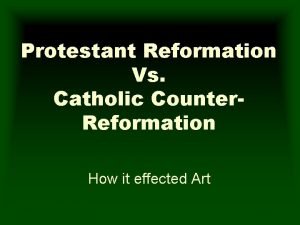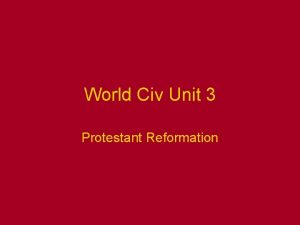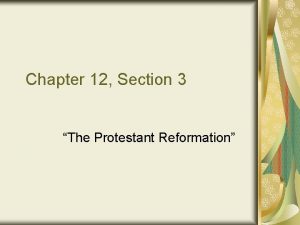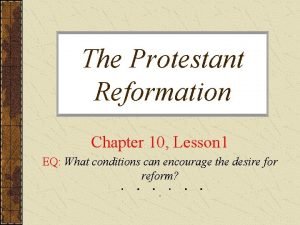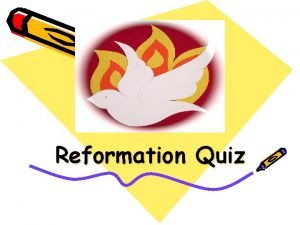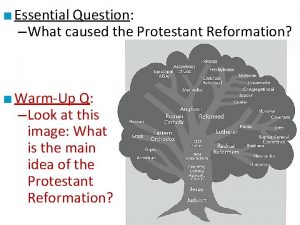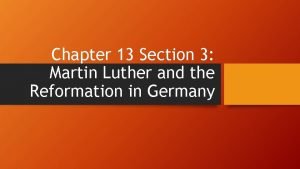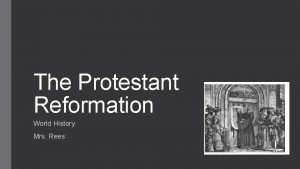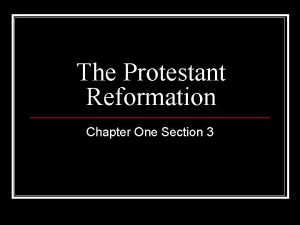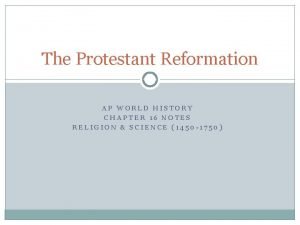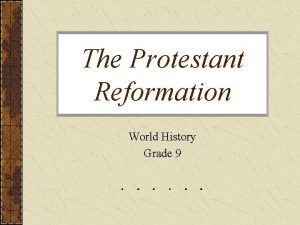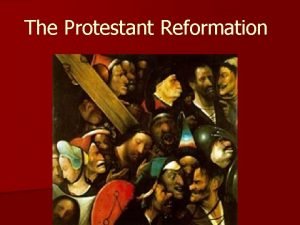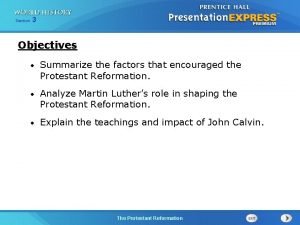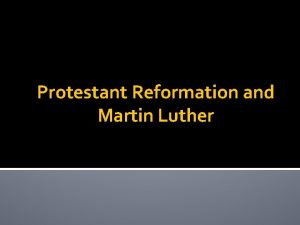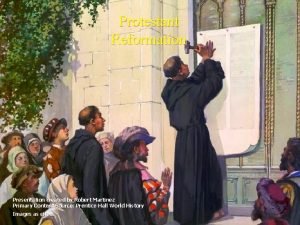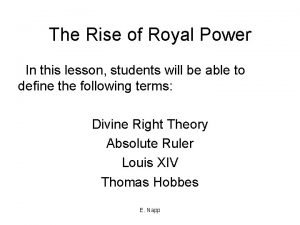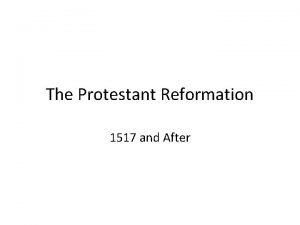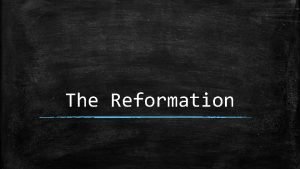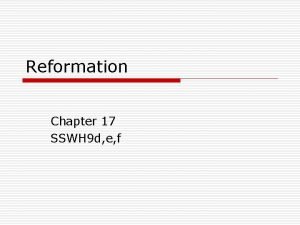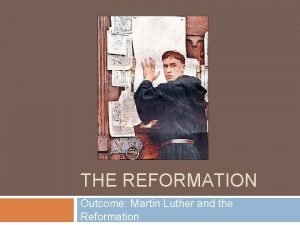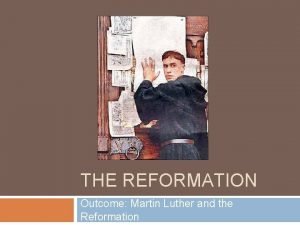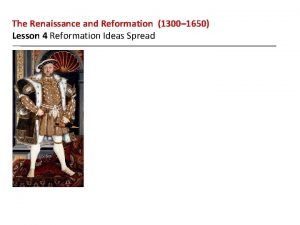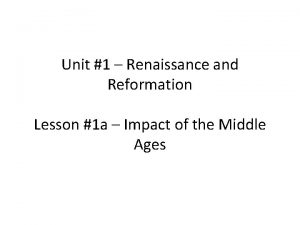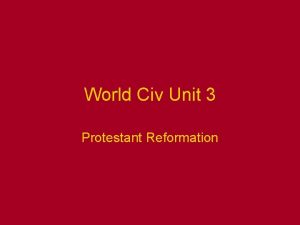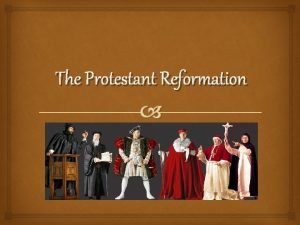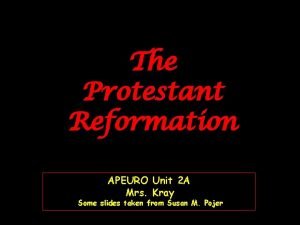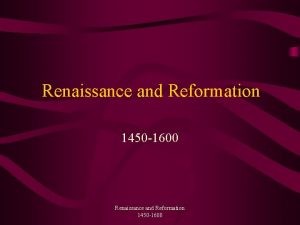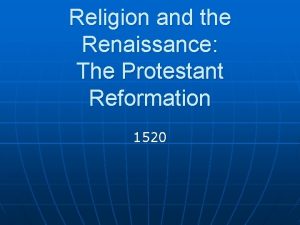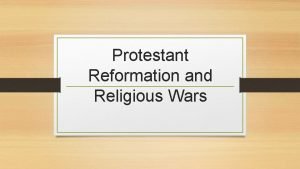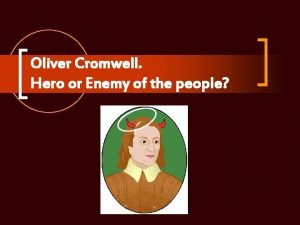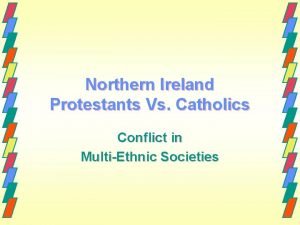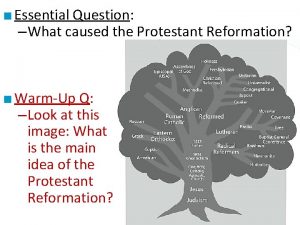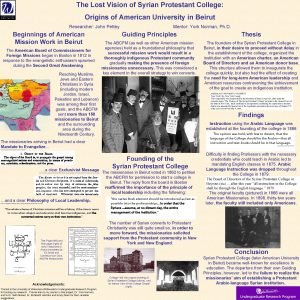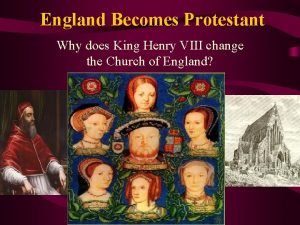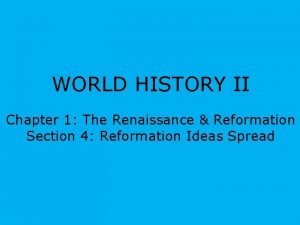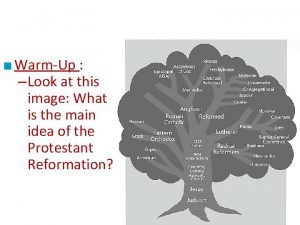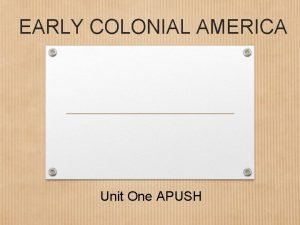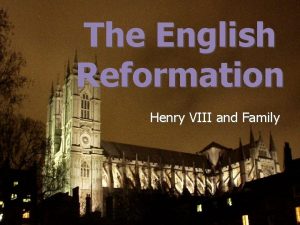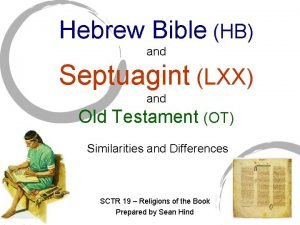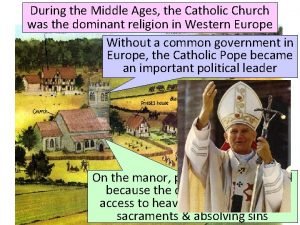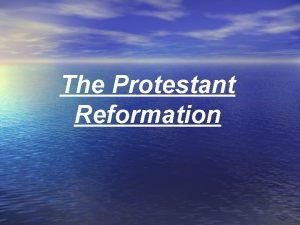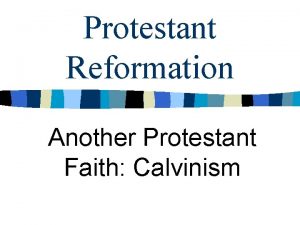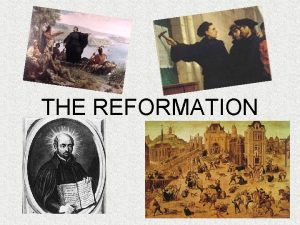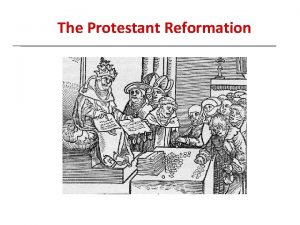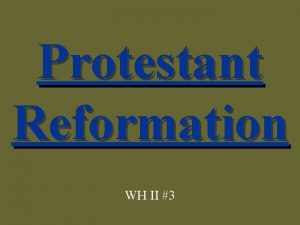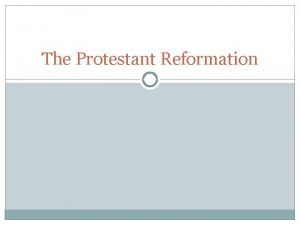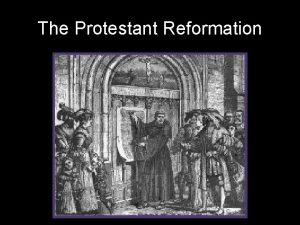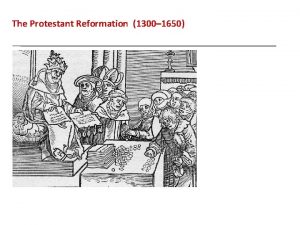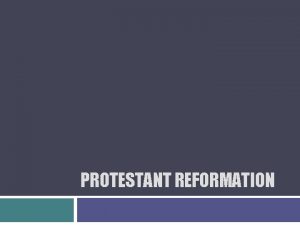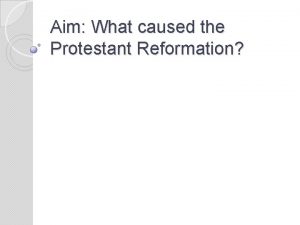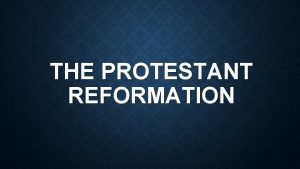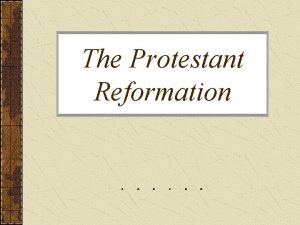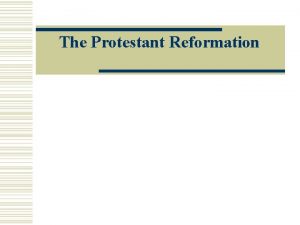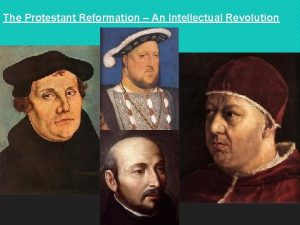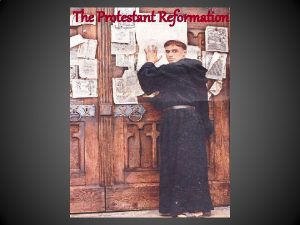The Protestant Reformation APEURO Unit 2 A Mrs




















































- Slides: 52

The Protestant Reformation APEURO Unit 2 A Mrs. Kray Some slides taken from Susan M. Pojer

Early Critics of the Church

Conciliar Movement • Attempted to use church councils to solve the Great Schism and to check the power of the papacy • Pope viewed as a threat to his power • Largely unsuccessful

Lollardism § Very popular in the 15 th c. § Papal claims of temporal authority had no basis in scripture § Church should be stripped of its property § Urged abolition of veneration of John Wyclif saints, pilgrimages, pluralism, and absenteeism § Women could be preachers

Jan Hus § Disputed papal authority, denounced abuses § Insisted church authority rested on the bible § Burned at the stake as a heretic in 1415 at the Council of Constance

Christian Humanists Thomas More Desiderius Erasmus Francois Rabelais Extremely critical of Catholic Church abuses, urged reform primarily through education.

The Protestant Reformation

R. H. Bainton The Reformation of the 16 c Thus, the papacy emerged as something between an Italian city-state and European power, without forgetting at the same time the claim to be the viceregent of Christ. The Pope often could not make up his mind whether he was the successor of Peter or of Caesar. Such vacillation had much to do with the rise and success of the Protestant Reformation.

Causes of the Reformation? § Papal need for money indulgences § Church corruption simony, nepotism, pluralism, absenteeism, indulgences § Avignon Papacy § Marsilius of Padua Defensor Pacis [Defender of the Peace] • Attacked papal authority • The Christian community is the sum of ALL its parts! § Development of personal devotions suspicion of clergy • Illiterate priests • Brothers and Sisters of the Common Life • Thomas a Kempis’s Imitation of Christ • Growing belief in mysticism § Greed of secular leaders § 1/3 of Europe = church land § Printing Press

The Holy Roman Empire in the 16 c

Martin Luther, 1483 -1546 • Educated at University of Erfurt – Intended to be a lawyer • Professor of scripture at University of Wittenberg • Came to believe salvation comes not through external observances & penance but through simple faith in Christ

The Indulgence Problem University of Wittenberg in jurisdiction of Magdeburg. The Archbishop Albert needed a papal dispensation to hold multiple offices. Albert borrowed the money from a wealthy banking family, the Fuggers Fugger to pay for the dispensation To repay the Fuggers, Pope Leo X, authorized Archbishop Albert to sell indulgences to repay Fuggers & to help raise money to build St. Peter’s Archbishop Albert hired John Tetzel to sell indulgences.

“As soon as coin in the coffer rings, the soul from purgatory springs”

The Ninety-Five Theses • Intended theses for academic debate • His arguments: – No biblical basis for indulgences • they undermined sacrament of penance, competed with preaching of the Gospel, & downplayed importance of charity in Christian life • This challenged the Pope’s authority since he had authorized indulgences • 1519 in a public debate Luther denied the general authority of the pope and the infallibility of the general council

The Power of the Press • In the first 10 yrs. of the Reformation, 25% of all the books published in Germany were by Luther! – “On the Freedom of the Christian” – rejected free will when it comes to salvation – On the Babylonian Captivity of the Church – condemned the 7 sacraments, only 2 had scriptural justification – An address to the Nobility of the German Nation – by supporting him they can resist Roman taxation and power – German translation of the Bible

Catholic vs. Protestant Thought Catholic Lutheran How is a person saved? Faith and good works Faith alone (sola fide) Where does religious authority reside? Bible and traditional teachings of the church Bible alone (sola scriptura) What is the church? The clergy and the Catholic Church in Rome Spiritual priesthood of he entire community of Christians “priesthood of all believers” What is the highest form of Christian life? Monastic and religious life are superior All vocations have equal merit How many sacraments? Seven Two Theology of the Eucharist Transubstantiation (baptism/Lord’s Supper) Consubstantiation

The Spread of Lutheranism

Charles V, • 1500 -1558 Most powerful ruler in Europe – Controlled Spain, the Low Countries, HRE, parts of Italy, & the Spanish Empire in the New World • Recognized the need for reform and continually pressured the pope to call a general council • Believed it was his duty to maintain the political unity of Catholicism

Diet of Worms, 1521 • Papacy had condemned Luther’s propositions, ordered his books burned, promised excommunication • Lutheranism was spreading rapidly – By Jan. 1521 “All Germany is in revolution. Nine-tenths shout ‘Luther’ as their war cry; the other tenth cares nothing about Luther, and cries ‘Death to the court of Rome. ” – papal legate • HRE Charles V ordered Luther to appear before the Diet and recant Luther refused Charles V declared him an outlaw – Duke Frederick of Saxony offered Luther protection

Why is Lutheranism So Popular? • Lay rulers liked that as Lutheran theology developed it exalted the state & subordinated the church to the state • Humanists attracted to Luther’s ideas of Church reform • Middle classes & business classes liked his insistence on literacy & the idea of salvation by faith alone – Resented tithes & ecclesiastical taxation – Disapproved of the luxurious lifestyle of some churchmen • Women liked Lutheranism’s exaltation of the home and woman’s special place in it. – Also liked emphasis on literacy – Also advocated marriage for clerics – Early on some women were preachers: Catherine Zell

Why is Lutheranism So Popular? • 15 th c. city governments resented clerical privileges – Priests, monks, & nuns paid no taxes – Exempt from civic responsibilities – Clergy held large amounts of urban property (up to 1/3) • Educated townspeople condemned irregularity & poor quality of sermons of illiterate clergy – Established preacherships (Brothers & Sisters of the Common Life) – These preachers became protestant leaders • Peasants liked Luther’s admiration of their hard work & his message: – “a Christian man is the most free lord of all and subject to none”

The Peasant Revolt, 1525 • Peasants worse off in 16 th c. than in the 15 th c. – Complained nobles had seized village common lands, imposed new rents & services • Drew up The Twelve Articles – Summarized agrarian crisis – Angered at noble seizure of common lands, new rents, etc. • Luther Denounced Peasants – “Against the Murdering Robbing Horde of Peasants” – Called for death of all who challenged legitimate authority

The Peasant Revolt, 1525 Revolt was crushed. More than 100, 000 peasants killed! Power of lay rulers strengthened.

The Peace of Augsburg, 1555 § Many saw repression of Lutheranism as a threat to state liberty – Germany fell into anarchy – Schmalkaldic League • Pro-Protestant • France aids Protestants (Habsburg. Valois Wars) § Charles V was forced to compromise with Lutherans b/c he faced so many other issues early in his reign § Peace of Augsburg – Victory for Lutheranism and states’ rights • “Whose rule, his religion” – Furthered disunity in HRE & Germany – Did not address Calvinism

Protestantism Expands

John Calvin, 1509 -1564 • 2 nd Generation Reformer • Institutes of the Christian Religion, 1536 – Believed in absolute sovereignty and omnipotence of God no free will – Predestination * • Centered in Geneva – “the elect” must create the “Most Holy City on Earth” – Model for 16 th c. Protestant reformers – Fundamental purpose of the political system was to fulfill moral law • Spread quickly – Presbyterians, Huguenots, Puritans

Calvin’s World in the th 16 c. • Geneva was a model for 16 th c. Protestant reformers • Calvinism Spread Quickly – Geneva Academy – Presbyterians in Scotland (John Knox) – Huguenots in France – Puritans in England

Ulrich Zwingli, 1484 -1531 • Est. a reform movement more radical than Luther – Disagreed w/Luther over Eucharist (consubstantiation) – Marburg Colloquy • Luther & Zwingli met & tried to settle their disagreement it fails • Laid basis for a different style of worship – Wanted believer’s attention focused on Word of God – Followers smashed organs, statuary, and painted churches white • 1531 – killed in Swiss Civil War

The Anabaptists • Membership in Christian community is a free choice that can only be made by adults – Adult baptism – Favored a return to the kind of church they thought had existed in among earliest Christians (voluntary association) • Took the Gospel literally when it came to worldly temptations – Advocated total separation of church and state – Refused public offices – Would not serve in the armed forces (pacifists) • Believed in religious tolerance • Admitted women to the ministry

Jan of Leiden • For the most part Anabaptists lived in small, peaceful communities, & didn’t pose a threat to the state one exception. • Declared himself King of Munster – Introduced polygamy – Burned all books except Bible • Tortured & executed by joint Catholic-Lutheran force

England the Protestant Reformation

Seeds of an English Reformation? • Demands for reform dated back to at least the 14 th c. – Lollardism – William Tyndale’s Bible • Still traditional Catholicism exerted an enormously strong hold over the imagination and loyalty of the people • So why the shift? William Tyndale

The Political Backdrop: The Tudor Family Mary Tudor (to Scotland) Arthur, Prince of Wales – died 1502 marr ied married Henry VII Prince Henry (future King Henry VIII) Catherine of Aragon

Henry VIII, 1509 -1547 § Loyal Catholic § Named “Defender of the Faith” by the Pope § But there’s no male heir Catherine of Aragon, Mary Tudor 1485 -1536 (28 yrs. old) § His wife is too old to have more children § Had six children, only one survived

Henry Seeks a Divorce § Henry wants to marry Anne Boleyn but must divorce Catherine first § Sends his chief advisor, Cardinal Wolsey to seek an annulment from the Pope § Argument: Pope had made a mistake in granting a dispensation for Catherine and Henry to marry in the first place b/c she was his brother’s widow

Henry’s Request is Denied Influence of Charles V – Catherine of Aragon’s nephew Sack of Rome, 1527 Henry argued that the pope’s dispensation had contradicted the law of God – that a man may not marry his brother’s widow. Had Clement admitted that Julius II had erred, Clement would have given support to the Lutheran assertion that popes substituted their own evil judgments for the law of God. Clement would not do that. And then there was the Charles V issue

Henry Breaks with Rome Archbishop Thomas Cranmer • Cranmer and Cromwell convince Henry that the only way to end his marriage was to make himself head of the Church of England Thomas Cromwell

England Breaks with Rome • Act in Restraint of Appeals (1533) – Declared the king to be the supreme sovereign in England forbad judicial appeals to the papacy • Act for the Submission of the Clergy (1534) – Required churchmen to submit to the king and forbade the publication of ecclesiastical laws without royal permission • Supremacy Act (1534) – Declared the king the supreme head of the Church of England • 1535 & 1539 under the influence of Thomas Cromwell, Henry dissolved the English monasteries.

Opposition to Henry’s Plan • 1536 – Pilgrimage of Grace – Massive multi-class rebellion in the north – Largest in English history Sir Thomas More, Lord Chancellor of England • 1546 – rebellions in East Anglia and in the west

Elizabeth I Marriage of Henry VIII & Anne Boleyn

Jane Seymour, 1508 -1537

“Baby” Edward VI

Henry VIII’s Family

Henry’s Other Wives Anne of Cleves, divorced Katherine Howard, beheaded for adultery Katherine Parr, widowed

Henry VIII Grows Old

King Edward VI, 1547 -1553 • Henry VIII’s Anglican Church had strong Catholic elements – Six Articles confirmed many distinctly Catholic practices for the Church like clerical celibacy • That changes with Edward – Strongly Protestant ideas exerted significant influence (Zwinglist) – Archbishop Cranmer very influential • Cranmer prepared first Book of Common Prayer and the Act of Uniformity which required use of the book

A Catholic Resurgence “Bloody” Mary Tudor, 1553 -58 • Edward VI died young, his sister Mary Tudor inherited the throne – Daughter of Catherine of Aragon • Devout Catholic • Married the Defender of Catholicism, Phillip II of Spain

Elizabeth I, 1558 -1603

Beginning of Stability • She’s a politique – Politique = someone who placed political unity above religious dogma – Doesn’t care what people believe privately • Elizabethan Settlement – Required outward conformity to the Church of England uniformity in all ceremonies • New Book of Common Prayer – deliberately very vague • Thirty-Nine Articles, 1563 – Basic tenets of the Church of England

Mary, Queen of Scots, 1560 -67 • Elizabeth’s position in England was precarious • Many wanted to overthrow her and place her cousin Mary, Queen of Scots on the throne but Mary had her own problems

The Church of Scotland: Prebyterianism • Scottish nobles supported reform movement • Lead reformer John Knox – Studied & worked w/Calvin in Geneva • Church of Scotland was strictly Calvinist but referred to themselves as Presbyterians • Rebelled against Mary John Knox – She fled to England – Elizabeth later executed her rival for treason

Protestantism in Ireland • The Church of Ireland was established on the English pattern • The (English) ruling class adopted the new reformed faith • Most of the Irish (probably for political reasons) remained Catholic
 Protestants vs catholic
Protestants vs catholic Unit 3: martin luther & the protestant reformation
Unit 3: martin luther & the protestant reformation Unit 3: martin luther & the protestant reformation
Unit 3: martin luther & the protestant reformation Unit 12 lesson 3 the protestant reformation
Unit 12 lesson 3 the protestant reformation Chapter 16 lesson 1 the protestant reformation answer key
Chapter 16 lesson 1 the protestant reformation answer key Protestant reformation quiz
Protestant reformation quiz What caused the protestant reformation?
What caused the protestant reformation? Chapter 13 section 3 the protestant reformation
Chapter 13 section 3 the protestant reformation Protestant reformation cartoon
Protestant reformation cartoon Give up one’s views or beliefs
Give up one’s views or beliefs Chapter 16 lesson 2 the spread of protestantism
Chapter 16 lesson 2 the spread of protestantism Crash course protestant reformation
Crash course protestant reformation The protestant reformation crossword puzzle
The protestant reformation crossword puzzle What factors encouraged the protestant reformation
What factors encouraged the protestant reformation Protestant
Protestant Protestant reformation
Protestant reformation Protestant reformation
Protestant reformation Protestant reformation map
Protestant reformation map Protestant reformation kahoot
Protestant reformation kahoot Counter reformation def
Counter reformation def The reformation outcome: martin luther and the reformation
The reformation outcome: martin luther and the reformation The reformation outcome martin luther and the reformation
The reformation outcome martin luther and the reformation They are mrs garcia and mrs castro
They are mrs garcia and mrs castro They are mrs garcia and mrs castro
They are mrs garcia and mrs castro Mrs. darling was ___________ of mrs. s.
Mrs. darling was ___________ of mrs. s. Unit 12 lesson 4 reformation ideas spread
Unit 12 lesson 4 reformation ideas spread Unit 4 lesson 1 the renaissance
Unit 4 lesson 1 the renaissance Unit 10, unit 10 review tests, unit 10 general test
Unit 10, unit 10 review tests, unit 10 general test Protestant beliefs
Protestant beliefs Protestant hierarchy
Protestant hierarchy Simony ap euro
Simony ap euro What is the difference between protestant and catholic
What is the difference between protestant and catholic Protestant religion
Protestant religion What do protestants believe
What do protestants believe Cromwell
Cromwell Northern ireland population catholic protestant
Northern ireland population catholic protestant Catholic vs christian
Catholic vs christian Syrian protestant college
Syrian protestant college England becomes protestant
England becomes protestant Describe the new ideas that protestant sects embraced
Describe the new ideas that protestant sects embraced Calvinism was the first protestant faith
Calvinism was the first protestant faith What was the first protestant faith? *
What was the first protestant faith? * Symbole protestant poisson
Symbole protestant poisson Protestant practices
Protestant practices Halfway covenant definition apush
Halfway covenant definition apush Problems in the catholic church reformation
Problems in the catholic church reformation Protestant vs catholic war
Protestant vs catholic war Protestant beliefs
Protestant beliefs Lexaria bioscience corp
Lexaria bioscience corp Catholic vs christian
Catholic vs christian Hát kết hợp bộ gõ cơ thể
Hát kết hợp bộ gõ cơ thể Lp html
Lp html Bổ thể
Bổ thể
